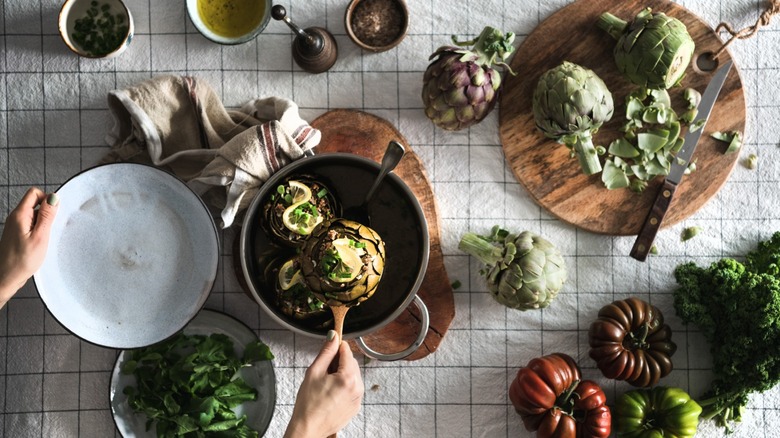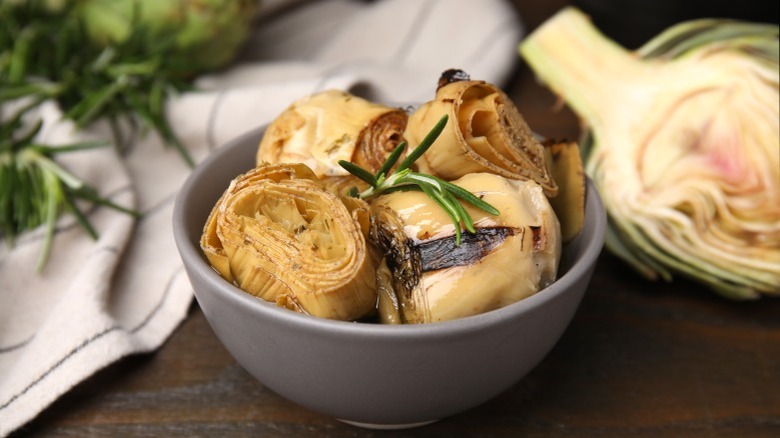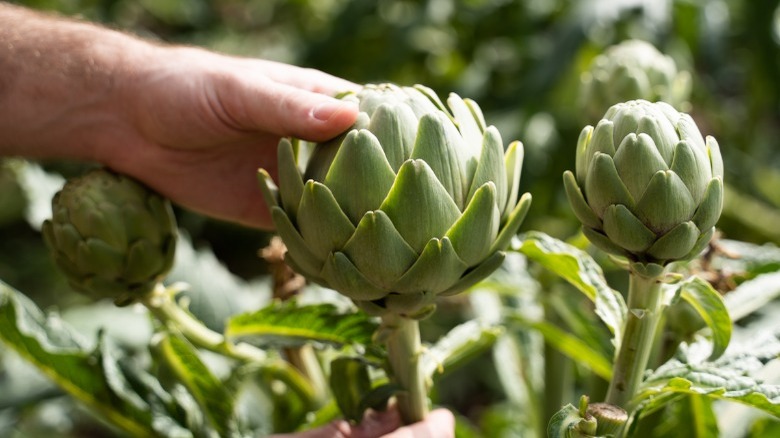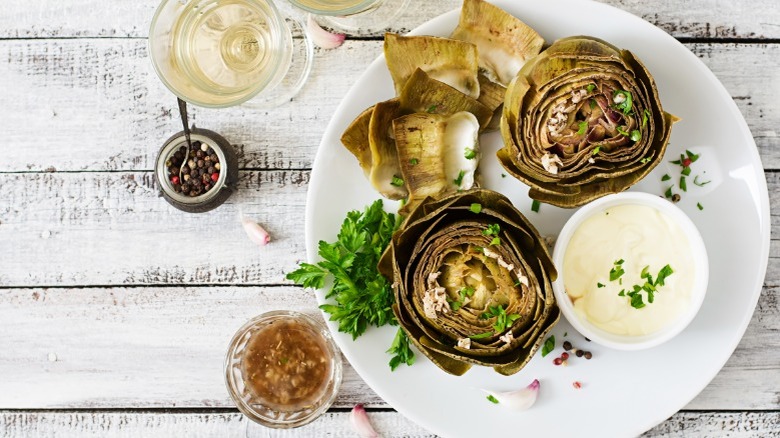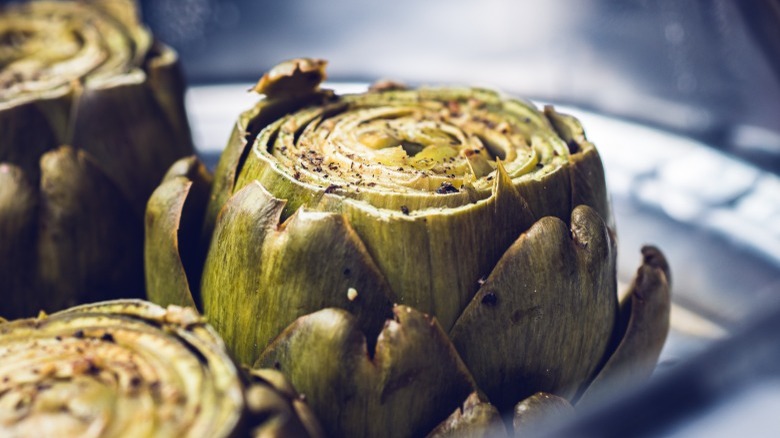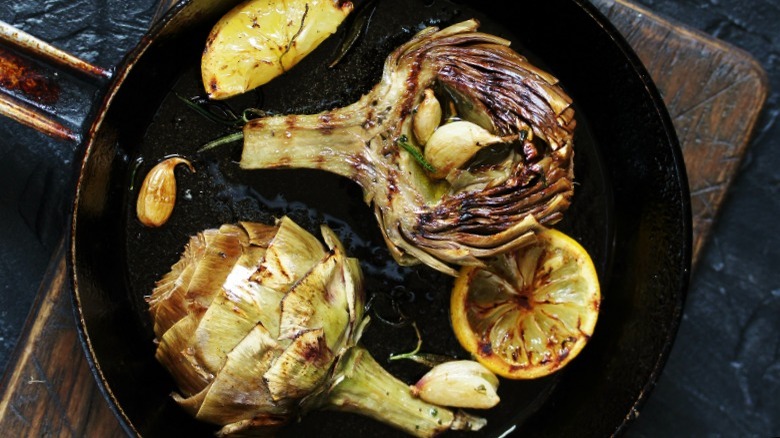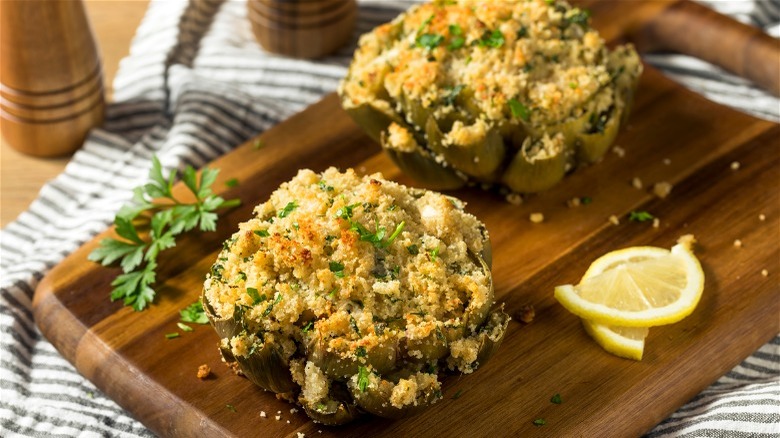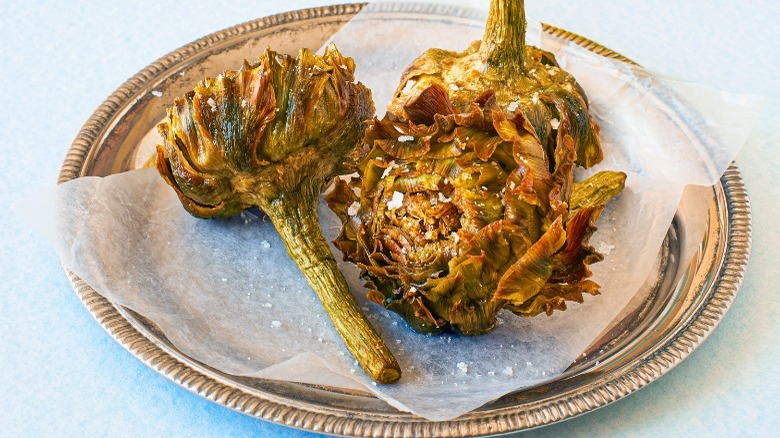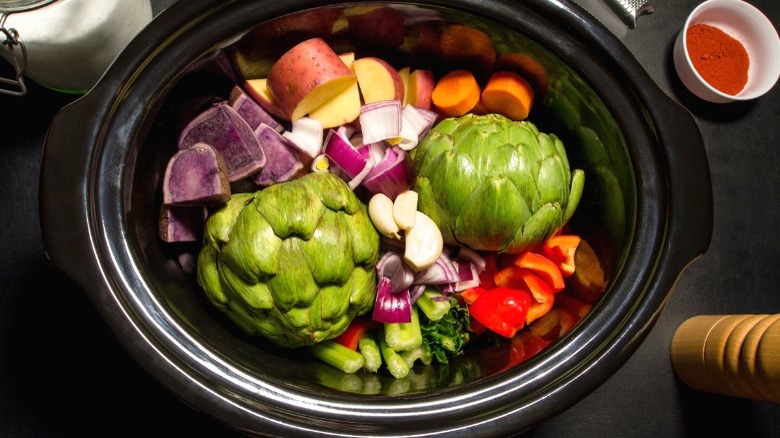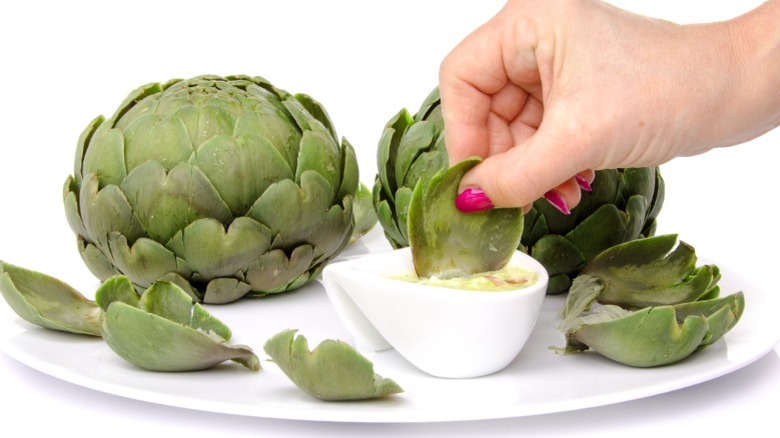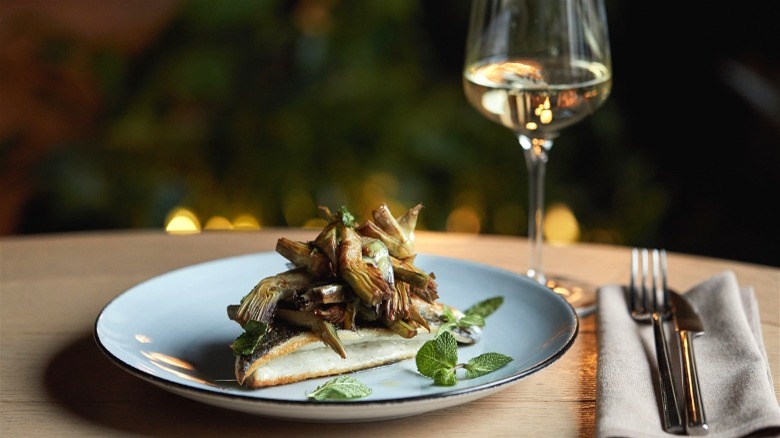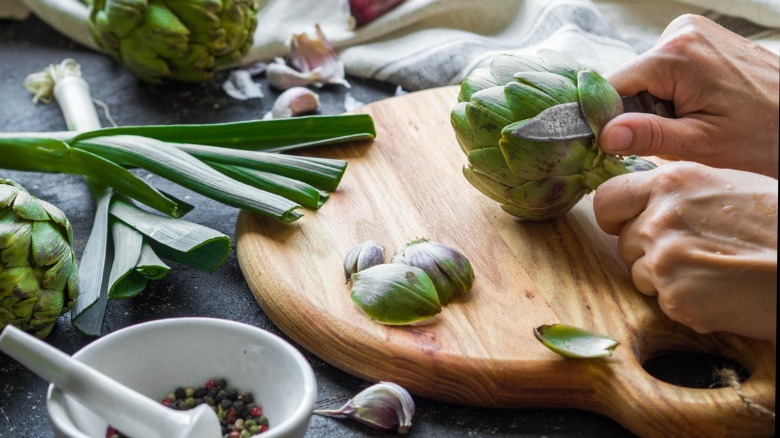13 Tips You Need When Cooking With Artichokes
Once these glorious green buds appear at farmers' markets, one thing is certain: Spring has arrived. But as tempting as it is to grab as many as you can carry and bring them home, the daunting prospect of prepping and cooking artichokes from scratch might stop you in your tracks. You're not alone: Even renowned chef Alton Brown has expressed his distaste for cooking artichokes, stating that they are more trouble than they're worth. But when you understand the anatomy of this unique plant (which is not a vegetable, but a thistle bud), as well as the basic principles of working with it, you'll find that it isn't all that intimidating.
If you've always wanted to learn how to pick and store fresh artichokes correctly, as well as master some common cooking techniques and best flavor combinations, this guide is here to help you harness their full potential. So get ready to delve into the art of prepping, eating, and matching artichokes with other foods and drinks and discover how to turn those often-discarded parts into scrumptious soups, dips, and side dishes.
Choose the right variety
When it comes to cooking with artichokes, you have fresh, frozen, canned, or jarred options to choose from. Each variety has its merits, depending on the season and the recipe you're whipping up. Spring is the perfect time to experiment with fresh artichokes, which have the best flavor and texture and can be cooked in various ways. However, opting for them will cost you more time and money, which is why you may want to use canned artichokes over fresh.
Canned artichokes have a long shelf life and are more affordable, but you need to look for organic canned artichokes to avoid BPA. Their mildly acidic brine usually contains sodium, so you should rinse them before using them in a recipe. Adding canned artichokes will benefit a veggie antipasti Italian pasta salad or any other dish that needs a tangy twist. On the other hand, jarred artichokes, typically marinated in olive oil, salt, and pepper, are perfect for salads or a delectable spinach-artichoke sandwich.
Finally, frozen artichokes are ideal for those seeking peak ripeness and vitamins out of season, but remember that defrosting will add an extra step to your cooking process. Fortunately, they're versatile and can be cooked into pasta dishes, casseroles, and stews or roasted like fresh ones.
Know how to pick and store them correctly
When shopping for artichokes, keep in mind that a ripe bud should feel heavier than expected, indicating it still has all its moisture. A tightly packed head also signifies that the artichoke isn't overripe and will be a delight to cook and eat. For a fun test, gently squeeze a leaf or two — the freshest ones will sound squeaky. If you're lucky enough to grow artichokes yourself, remember to harvest the buds before they open. Otherwise, you'll get tough leaves that are borderline inedible.
Regardless of where you get them from, artichokes should be refrigerated. They can last up to two weeks in the fridge if kept at an ideal temperature of 32 degrees Fahrenheit. Store them in a jar partly filled with water, tented with a plastic bag, or treat the stems to a bit of water, wrap them in plastic, and place them in the crisper drawer.
If you plan to freeze artichokes, cook them first, run lemon juice over the surface, and store them in an airtight container for up to ten months. Oil-preserved artichokes can be stored in your pantry for up to eight months, but they probably won't last that long!
Master the art of prepping them
If you've only worked with canned artichokes before, handling fresh ones might seem intimidating. But it doesn't have to be! To cut an artichoke, snip off the tough outer leaves until you reach the softer, yellowish ones. Then, trim an inch or two from the prickly top part and cut the pointy tops off the remaining leaves. Finally, don't forget to peel the skin off the stem — the remaining bits will be quite tasty.
As tempting as it might be, you shouldn't eat the whole artichoke because it contains some inedible — and potentially dangerous — parts. The fuzzy choke in the center of the bud, right above the heart, poses a choking hazard (as the name suggests) and must be removed. If you only take one thing away from this article, it should be a hack that will make artichoke prep a breeze and save you a trip to the hospital: Snip through the center a few times with kitchen shears and scoop everything out with a teaspoon.
Once you've removed the fuzzy chokes, follow the advice of Andrew Zimmern, who suggests giving artichokes an acidulated bath to stop them from turning brown. That means placing your prepped buds into a bowl of cold water with lemon juice and wedges until you're ready to use them.
Bring out their best with complementary flavors
Artichokes offer a unique and agreeable flavor that can be enhanced by the right pairings. Their aromatic profile is a delightful blend of fruity, spicy, and green, featuring hints of rose, maple, honey, and even cheese. Thick, creamy dipping sauces, whether dairy or plant-based, complement artichoke's taste and texture perfectly — think Hollandaise, aioli, remoulade, mayo, or melted butter.
One of the main reasons artichokes work so well with lemons and other citrus fruits is their natural floral and citrusy aroma. Tangy ingredients like vinaigrette, yogurt, and tomatoes enhance artichoke's flavor profile, while arugula and spinach serve as excellent bases for artichoke salads. Their fruity scent also creates a harmonious match with sweet yet earthy ingredients like butternut squash, beets, and edamame. Their spicy clove notes can be emphasized by mint, sage, rosemary, thyme, and bay leaf, as well as warming spices like cinnamon, nutmeg, and ginger.
You also can't go wrong pairing artichokes with various members of the allium family — dressing them in a shallot vinaigrette can be particularly exquisite. Finally, adding umami-packed truffles can turn your artichoke dishes into an everyday luxury, but ordinary mushrooms also make a great pairing.
Opt for steaming instead of boiling
It's no wonder steaming and boiling are the two most popular artichoke cooking methods, as they require minimal effort once the artichokes are prepped. But deciding which one will be your go-to choice comes down to personal preference.
If you're seeking perfect texture, steaming is an excellent option — you don't want to waterlog all that goodness you've worked hard to prepare. Infusing the steaming water with aromatic ingredients like lemon, fresh garlic, and bay leaf can elevate the artichoke's final taste. Steam them as you would any other vegetable, but remember that the cooking time will vary depending on the bud size, usually 25 to 40 minutes.
On the other hand, if you're an artichoke flavor purist or simply don't own a steamer basket, boiling them might be the way to go. This method results in a softer texture, perfect for dishes like spinach and artichoke dip. Plus, this way, they'll likely cook faster, taking anywhere from 15 to 30 minutes. To check if they're done, use kitchen tongs to gently remove a leaf from the center — if it comes off easily, your artichokes are ready. Then, enjoy them on their own, or pair them with melted butter or your favorite sauce.
Caramelize them on a grill or stovetop
Here's a piece of good news: You don't really need to go above and beyond when making grilled artichokes. In fact, four ingredients and a well-heated grill are all you need to make this delectable seasonal appetizer. Simply halve the artichokes or cut them into wedges before washing and steaming them for about ten minutes. They'll then need roughly the same amount of time on a medium-high heat grill alongside fresh lemons, which will allow them to caramelize, balancing out their tartness. To finish, all you need is a sprinkle of salt and a squeeze of grilled lemon juice for a dish as simple as it is delicious.
For those without a grill, braising offers an alternative way to achieve similar caramelized flavors. To make an easy Greek braised artichokes and peas dish, soak prepped buds in acidulated water, drain, and combine with onions, carrots, stock, peas, and lemon juice. In just 20 minutes, you'll have a tasty and satisfying plant-based meal ready to serve. Allow it to cool down, and enjoy it with some crusty bread.
Stuff and roast them
Once you get the hang of the simple artichoke cooking methods (and go through multiple prepping sessions), you should feel confident enough to stuff and roast the delicious buds. The former adds an extra layer of texture, while the latter seals in all those extra flavors, transforming artichokes into a satisfying standalone dish.
One of the most common ways to make stuffed artichokes involves combining olive oil, breadcrumbs, crushed garlic, chopped parsley, salt, pepper, and grated Parmesan (or nutritional yeast, in case you're a plant-based artichoke lover). Pro tip: Using fresh homemade breadcrumbs will add to the allure of the dish.
Next, you'll need to carefully spoon the stuffing mixture into the spaces between the artichoke leaves, trying to distribute it evenly. Using fresh artichokes is fine if you plan to cook them on the stovetop in a broth of sorts. Alternatively, parboil them before the stuffing step if you plan on roasting them. If that's the path you take, place them in the oven, covered in foil, for 15-20 minutes or until the leaves are tender and the stuffing is golden brown.
Adopt Roman cooking methods
If you've never had the pleasure of savoring fried or braised artichokes, Italian cuisine offers some intriguing recipes. Believe it or not, there are not one but two Roman culinary traditions that showcase how little is needed to create an outstanding artichoke dish.
First, there's Carciofi Alla Giudia, which translates to "Jewish-style artichokes" and stems from Rome's historic Jewish community. This dish features flower-like artichokes that are flattened and fried until crispy, creating a delightful contrast between the tender heart and the crunchy exterior. Then, there's Carciofi Alla Romana, or "Roman-style artichokes," which offers a different take on the beloved vegetable. For this dish, artichokes are braised with olive oil, white wine, and a blend of herbs, resulting in a succulent and flavorful dish.
The good news is that traveling to the Eternal City to enjoy these scrumptious dishes won't be necessary. To prepare these culinary gems at home, start by getting your hands on some Roman artichokes — they work exceptionally well because all of the plant's parts are edible (as opposed to the hairy insides of the globe artichoke that need to be scooped out), and the prep will be less labor-intensive. Whichever dish you make, you'll explore Italy's culinary heritage while improving your artichoke-cooking skills.
Use different appliances
No matter what kitchen equipment you own, rest assured that you can use it on the humble artichoke. Besides the oven, stovetop, and grill, there's a plethora of devices you can use on these sturdy vegetables, each with its own benefits.
Steaming artichokes in the microwave is not only easy, but it also helps retain their nutrients and reduce cooking time. Simply place the prepared artichokes in a microwave-safe dish, add a bit of water, cover with plastic wrap, and cook for 5-10 minutes, letting it rest undercover for a bit afterward. Alternatively, you can steam artichokes in an Instant Pot or another pressure cooker for tender, flavorful artichokes in record time. This method also helps retain nutrients while using less energy.
Air frying artichokes offers a healthy alternative to deep-frying, achieving a crispy exterior without excessive oil. This technique is perfect for those who prefer a crunchy texture while maintaining the artichoke's natural flavor. Slow cookers, on the other hand, provide a low and slow cooking method that allows the flavors to meld beautifully, resulting in fork-tender artichokes. This method is ideal for incorporating artichokes into dishes like soups, stews, or casseroles or making slow cooker spinach and artichoke dip.
Learn how to eat them
Artichokes are a truly special vegetable, and it is reflected in their eating approach as well. Having a whole (or halved) artichoke on your plate can be daunting if it's your first time. But you won't ever have to stress over it again after learning the artichoke philosophy: Relax, take your time, and savor each delicious bite.
As for concrete steps, you'll want to remove an outer leaf by gently pulling it away from the base. Dip the fleshy bottom part of the leaf into the sauce, then place it in your mouth. Gently bite down and scrape the tender portion with your teeth, discarding whatever remains. Repeat this process until you reach the lighter-colored inner leaves, which are more delicate and can be eaten whole.
As you work your way through the bud, you'll eventually uncover the coveted artichoke heart. But unless someone did it for you, you'll need to remove the fuzzy inedible choke first: Scrape it away with a spoon, making sure not to damage the delicate parts beneath it. Once that's over with, cut the heart into bite-sized pieces, dip it in your favorite sauce, and relish the delectable reward for your efforts.
Know what to pair them with
Did you know that artichokes have a unique ability to affect the taste of other foods? This intriguing phenomenon is caused by cynarin, a compound so integral to the plant's essence that it's named after artichoke's official title, Cynara scolymus. It's capable of temporarily altering our taste buds by inhibiting the sweet receptors, which in turn makes any other food you bite into afterward taste sweeter. Unfortunately, this outstanding quality is the reason why sommeliers avoid artichokes — they simply can't allow them to mess with the flavors of fine wines.
However, this bit of food science can be used to your advantage when it comes to pairing artichokes with other foods and drinks. One way to capitalize on this effect is by pairing artichokes with slightly bitter or acidic foods — the cynarin in artichokes will soften these flavors, creating a sense of balance. Another option is to combine artichokes with mild-tasting foods like pasta, tofu, or mashed potatoes. With artichoke's flavor-enhancing properties, these simple ingredients will taste more indulgent and satisfying.
And, of course, you can still enjoy them with wine. A crisp, refreshing white wine, such as Vinho Verde or Txakoli, typically has sufficient acidity and herbaceous notes that can match the artichoke's flavor profile and counteract the effect of cynarin.
Eat them raw
Much like broccoli, artichokes are conventionally thought of as a vegetable that requires cooking but that is perfectly pleasant raw, as long as it's fresh and not overly mature. And that goes for any artichoke variety! To savor raw artichokes, remove the tough outer leaves and scoop out the fuzzy choke, then simply pull off the leaves and scrape the "meat" with your teeth. Don't forget to enhance the flavor by pairing them with high-quality olive oil, a smoky remoulade, or any other dipping sauce you prefer.
If you're in the mood for a raw artichoke salad, there are several ways to go about it. One easy method is to thinly slice them lengthwise after you've prepped them as you normally would for cooking, then toss them with chopped herbs, olive oil, lemon juice, and seasoning. Feel free to add garlic, greens, and cheese for extra flavor. Another option is to let the prepped artichokes rest in a lemon water bath to prevent oxidation. After draining, use a mandolin to achieve perfectly thin slices and enjoy their mildly tangy fresh flavor in your favorite salad.
Don't get rid of the scraps and leftovers
Those trying to adhere to a low-waste cooking philosophy will be happy to learn that you can transform your artichoke scraps and leftovers into culinary delights. With a creative and mindful approach, you can minimize waste and maximize flavor, making the most of every part of the artichoke.
Fresh artichoke scraps (namely, peels, stalks, and leaves) can be boiled and then pureed using a food processor or rotary vegetable mill. This versatile substance can be added to bean dips, mayonnaise, and other sauces or combined with potatoes, leeks, and onions to create a comforting soup. Remember, the cooking water is valuable too! Reuse it to make a delicious spaghetti aglio e olio with an artichoke twist. And if a recipe calls for only artichoke hearts, don't fret — simply freeze the remaining leaves and stalks until you're ready to use them in a stock or repurpose them as a standalone side dish.
If you're in the mood for culinary "Inception," you can turn leftover stuffed artichokes into stuffed mushrooms (although simply steamed artichoke leftovers will probably be more versatile). Lastly, you can elevate your sandwich game by transforming leftover spinach-artichoke dip into a sophisticated grilled cheese. The possibilities are endless when you choose to get creative with this glorious vegetable.
Static Media owns and operates Tasting Table and Mashed.
